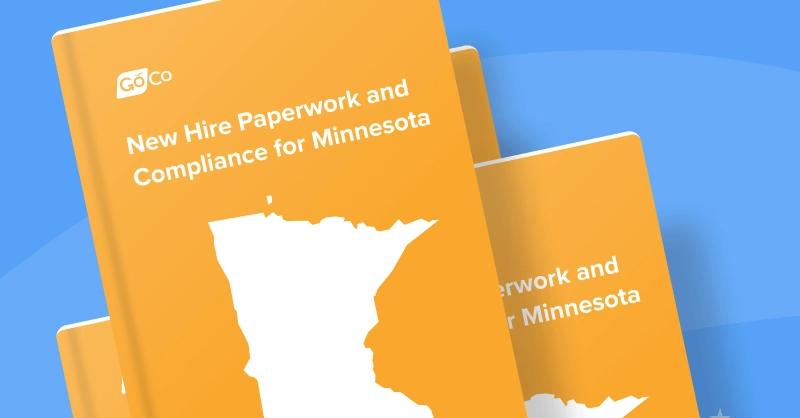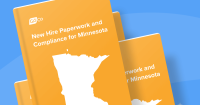New Hire Paperwork and Compliance for Minnesota
What new hire paperwork in Minnesota do employers need to know about? This guide breaks it down.
September 22nd, 2023
Whenever someone gets hired, there is going to be paperwork that they need to fill out. This paperwork for new hires allows the government to have the appropriate information not only for that new hire but also for your company.
As the HR representative, it will be your responsibility to gather the proper onboarding documents for these new employees.
What is Minnesota's typical onboarding process? What new hire paperwork in Minnesota do you need to know about? This guide breaks it down.
Download The Ultimate Onboarding Checklist
W-4
One piece of paperwork that comes directly from the IRS is the W-4 form. All new employees need to fill this out as it is for tax purposes. This is something that every state in the country requires because it comes from the federal level.
What does this entail? It will start with basic information such as the employee's name, address, social security number, and filing status.
The rest of this form greatly depends on what kind of claims the employee wants to make on their taxes at the end of the year. Part of this comes down to if that employee is filing by themselves or if they are filing jointly with a spouse.
Then, consider if that employee has any kids or not. If they do, they will likely claim the kids living with them as dependents. This can give someone a massive break on their taxes, so it can be a crucial part of this form to fill out properly.
Another thing that this form will ask someone about is other forms of income that this person has. An example could be putting a spouse's income on here if someone is filing jointly. Or, if that person has a second job, they would have to disclose how much income they make per year from that other job.
On top of additional income, the IRS will want an employee to claim any deductions that they may want to make at the end of the year on this form. This can also help them save money on taxes.
This is a big part of onboarding because this is a form that goes all the way up to the federal level. Make sure you remember to give an employee this form.
W-4MN
In addition to the W-4 above, an employee will have to fill out this form as well to disclose their withholding allowance. The main difference between this and the W-4 is that instead of this going towards federal taxes, this impacts taxes on the state level.
There may be different tax brackets and tax exemptions in Minnesota compared to the federal level. This form helps inform employees of that and gives them a better idea of what deductions and exemptions they can get with Minnesota state taxes.
Hand this to your employees to make sure they understand the state tax implications.
Wage Theft Notice
Something else that employees in Minnesota may have to fill out is a Wage Theft Notice form. The exact details of this form will vary depending on what company you work for.
The purpose of this form is to protect both employees and employers from wage theft. How this is done is that the company gives this form to employees, going over their wage rights along with any additional perks. On top of this, the form goes over expectations that the employer has with the employee to make sure that they do not commit wage theft either.
This can be as simple as going over how much money an employee is entitled to if they are getting paid an hourly wage. The same applies if they are a salaried employee.
Then, it could discuss things such as what an employee has to do to earn a bonus and other benefits.
If you are part of a very corporate company, you may even have an allowance for certain things. This includes business expenses such as meals and lodging if someone is trying to have a business meeting with a client.
You need to have a clear and upfront policy on things like this. It lets the employees know what they are entitled to in certain scenarios.
For example, let's say that you are willing to cover business meals and business lodging for employees. You may require the employee to keep all of their receipts and reimburse them after the fact. Or, you may require additional documentation, such as the potential client's name to explain why the business expenses were necessary in the first place.
The point is that this notice makes it easier for employees to be aware of the rules and their rights up front.
Notice of Review of Personnel Records
Something else that your employer has to do with new employees is to let them know that they have a right to search their personnel records. This could give an employer grounds to let go of an employee or not take them further into the hiring process.
Think of this like requesting an employee to sign some papers to condone a background check. In some situations, the new hire may be pending a background check while you are onboarding them. You simply need to request a new employee's signature and encourage them to read the fine print of this notice.
This notice will let the new employee know in detail what the company may be searching for. This can be anything from a criminal background check to social media records, past performance, and more.
Because this can contain potentially sensitive information, Minnesota requires you to get somebody's consent before you start to do this background check on them. Make sure that you do not forget to give this form to a new employee.
Notice of Drug and Alcohol Policy
This next form is going to depend on the company that you work for. If your company has any sort of formal policy against drug and alcohol use, they will be required to give a Minnesota employee a form to fill out that goes over this policy.
This policy form should state every rule and circumstance that your company has on this subject. This includes what happens if you get caught drinking on the job, showing up to work drunk, getting caught with drugs on company property, if employees have to take drug tests, and more.
Companies do have the right to force their employees to submit to a drug test. However, this has to be clearly stated in advance, and an employee has to consent to this.
That is where this policy form comes into play. It allows the employee to give the company consent to do things like this while they are in the employee onboarding stage. This can also help both sides avoid potential problems later.
I-9
Another form you may need at the federal level is the I-9 form.
What is the I-9 form? It helps the federal government ensure that the employee that you are hiring is legally eligible to work in this country.
Depending on someone's visa status or background, they may not be eligible to work certain jobs. An example could be someone who has a lengthy criminal record not being eligible for a government job.
However, this does apply to people who are on certain visas. If someone from another country wants to work while they are on a visa, they need the proper business visa to be legally eligible to work for you. Being on a normal visa usually does not legally permit someone to work while they are in the United States.
The I-9 is not just for employees that you are in the onboarding process with. Companies are supposed to keep this form after the employee leaves your company for up to three years.
Make sure you review the requirements around this form carefully.
New Hire Reporting
This is another requirement for pretty much any state in the country. Companies must report a new hire to their local jurisdiction within 20 days of hiring the new employee. This helps the government keep up with eligibility for each employee along with taxes for both them and your company.
W-2
Finally, you have a W-2 form. This is something that an employee will use to show the government how much money they made that year. On top of this, it will show what taxes were taken out of your paychecks for the year.
Employees can use this form to file their own federal and state taxes. Then, depending on what they have on that form, this could help them get a tax refund at the end of the year.
Organize Your Onboarding
These are some of the onboarding documents you are going to need if you are an HR rep in Minnesota. Of course, you need to start with the W-4 to satisfy the IRS. However, you will also need the W-4MN to satisfy state tax regulations.
On top of these two documents, look into forms for wage theft, alcohol and drugs, personnel records, local regulations, and more.
If you are looking to streamline your onboarding process and paperwork, take a tour of GoCo today to see how we can help.
Recommended Posts
Search...
Product
GoCo
Resources
Articles
eBooks
Webinars
Customer Stories



